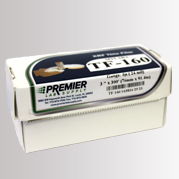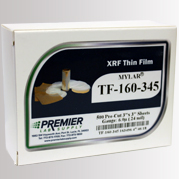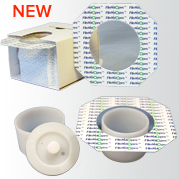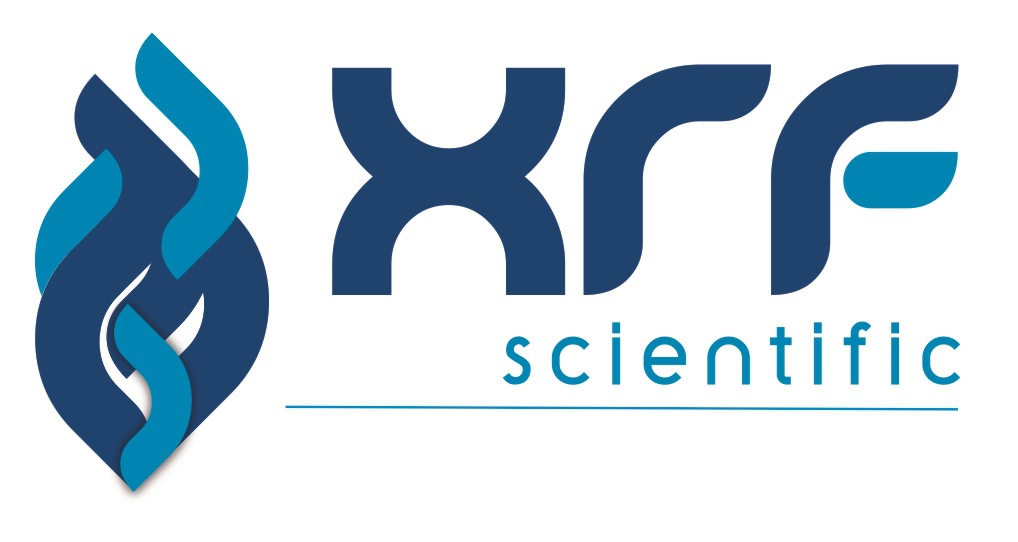Mylar Film
Disposable XRF sample cups require attachment of Thin Film Sample Support Materials to retain various forms of sample including liquids, powders, slurries or solid specimens.
The suitable selection of Thin Films available as attachments to sample cups for X-Ray Fluorescence depends upon the sample at hand and each of their distinct characteristics to secure the sample while allowing uniform transmission of the X-Ray to the sample. Strength, Thickness, Transmission and Metallic Impurity levels will define your suitable selection. Keeping this in mind, your sample’s chemical characteristics may ultimately dictate your choice of Thin Film Sample Support Materials.
Because Thin Film Transmission Characteristics cover a wide range of wavelengths for various types of Thin Films, Mylar® is generally the typical selection for XRF. Mylar is economically priced, exhibits good tinsel strength, and endures reasonable resistance to chemical attack. Mylar Film also provides good transmission characteristics over a broader range of compounds. Polypropylene exhibits slightly lower tinsel strength than Mylar, but also tends to exhibit greater endurance to chemical attacks from a wider range of compounds. Kapton® (Polyimide) may also be selected as a Thin Film Sample Support Material. Kapton (Polyimide) exhibits the lowest transmission characteristic than most other Thin Films.
However, trace element analysis should be given special consideration with respect to purity levels inherent in various Thin Films. While generally not at levels of concern for most applications, Mylar Films may contain ppm levels of Ca, Cu, Fe, P, Sb, and Zn. Alternatively, Polypropylene Films may contain trace levels of Al, Ca, Cu, Fe, P, Ti, Tn, and Zr. Therefore, because Kapton® (Polyimide) is virtually free from trace metal impurities, Kapton® would be the appropriate selection of Thin Film for low-level determinations of these elements.
All of Premier Thin Film Sample Support Materials are carefully selected because of their minimum trace levels of impurities along with uniformity of thickness to ensure reproducibility from one lot to the next. Premier recommends that the final selection of your Thin Film should be tested outside of the XRF Instrument with respect to physical strength and endurance to Chemical Attacks from the sample at hand. Premier offers Thin Films in sample quantities for our customers for testing purposes.
Premier XRF Thin Film Sample Support Material provides Spectroscopist’s with the best overall value in the industry from price, value to selections. Premier Thin Films for XRF are available in Continuous Rolls; Pre-Cut Sheets and Pre-Cut Circles.
System Users Menus Content Components Extensions Help RJM Systems (P... RJM Systems (Pty) Ltd Article Manager: Edit Article Save Save & Close Close Help Title * Thin Film Alias thin-films Content Publishing Images and links Options [Toggle Editor]
The suitable selection of Thin Films available as attachments to sample cups for X-Ray Fluorescence depends upon the sample at hand and each of their distinct characteristics to secure the sample while allowing uniform transmission of the X-Ray to the sample. Strength, Thickness, Transmission and Metallic Impurity levels will define your suitable selection. Keeping this in mind, your sample’s chemical characteristics may ultimately dictate your choice of Thin Film Sample Support Materials.
Because Thin Film Transmission Characteristics cover a wide range of wavelengths for various types of Thin Films, Mylar® is generally the typical selection for XRF. Mylar is economically priced, exhibits good tinsel strength, and endures reasonable resistance to chemical attack. Mylar Film also provides good transmission characteristics over a broader range of compounds. Polypropylene exhibits slightly lower tinsel strength than Mylar, but also tends to exhibit greater endurance to chemical attacks from a wider range of compounds. Kapton® (Polyimide) may also be selected as a Thin Film Sample Support Material. Kapton (Polyimide) exhibits the lowest transmission characteristic than most other Thin Films.
However, trace element analysis should be given special consideration with respect to purity levels inherent in various Thin Films. While generally not at levels of concern for most applications, Mylar Films may contain ppm levels of Ca, Cu, Fe, P, Sb, and Zn. Alternatively, Polypropylene Films may contain trace levels of Al, Ca, Cu, Fe, P, Ti, Tn, and Zr. Therefore, because Kapton® (Polyimide) is virtually free from trace metal impurities, Kapton® would be the appropriate selection of Thin Film for low-level determinations of these elements.
All of Premier Thin Film Sample Support Materials are carefully selected because of their minimum trace levels of impurities along with uniformity of thickness to ensure reproducibility from one lot to the next. Premier recommends that the final selection of your Thin Film should be tested outside of the XRF Instrument with respect to physical strength and endurance to Chemical Attacks from the sample at hand. Premier offers Thin Films in sample quantities for our customers for testing purposes.
Premier XRF Thin Film Sample Support Material provides Spectroscopist’s with the best overall value in the industry from price, value to selections. Premier Thin Films for XRF are available in Continuous Rolls; Pre-Cut Sheets and Pre-Cut Circles.
System Users Menus Content Components Extensions Help RJM Systems (P... RJM Systems (Pty) Ltd Article Manager: Edit Article Save Save & Close Close Help Title * Thin Film Alias thin-films Content Publishing Images and links Options [Toggle Editor]
Thin Film
Thin Film - Rolls

Thin Film - Pre-Cut Circles

Thin Film - Sheets

Film Velopes


